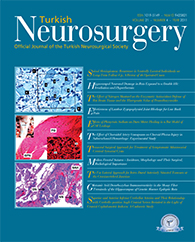2China Medical University, Department of Centre of Experiment Technology, Shenyang, China DOI : 10.5137/1019-5149.JTN .4474-11.1 AIM: Occlusion of the middle ferebral artery in rats may cause secondary injury that is not associated with middle ferebral artery feeding zone. This entity has been investigated very rarely.
MATERIAL and METHODS: HE staining method observed the changes of cerebellar cortex after MCAO operation. Electron Microscopy and TUNEL methods observed the apoptosis of neural cells of cerebellar cortex after MCAO in rats. Immunohistochemical analyses method observed the caspase-3 in neural cells of cerebellar cortex.
RESULTS: The results of HE staining indicated that no ischemia-necrosis changes of cerebellar cortex tissue were observed after MCAO operation by HE staining. Further experiments by Electron Microscopy and TUNEL assay revealed that the apoptosis of neural cells of cerebellar cortex were induced after MCAO in rats. Furthermore, immunohistochemical analyses showed that caspase-3 played an important role on MCAO-induced apoptosis of neural cells of cerebellar cortex.
CONCLUSION: These data showed for the first time that the role of caspase-3 in the mechanism of secondary injury of separated infarction in cerebellar cortex after middle cerebral artery occlusion in rats and it might give a new treatment strategy for individuals with human ischemic stroke.
Keywords : Cerebral infarction, Stroke, Cerebellar cortex neural cells, Apoptosis, Caspase-3




